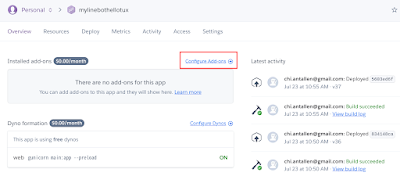- 了解 Line Bot 上的 FlexMessage 用法!
- 設定 FlexMessage 連結 Line Bot 機器人資料庫!
產生 FlexMessage 程式碼
- 登入 Line Developers ,查看 Flex Message Simulator
- 利用「Showcase」選擇自己想要的範例!利用「View as JSON」可以查看檔案內容!
- 新增 app/flexmodules 子目錄,方便存放Flex Message 程式!
- 利用 Python 程式,產生所需要的 JSON 檔案格式,傳送給 Line 平台!例:flexmessages.py
def fleximage(url): return { "type": "image", "url": url, "size": "full", "aspectRatio": "20:13", "aspectMode": "cover"} def flextext(text,size,color,weight='regular',wrap=False): return { "type": "text", "text": text, "size": size, "color": color, "weight": weight, "wrap": wrap } def flexlogo(text='大學麵店'): return flextext(text, size='md',color='#066BAF', weight='bold') def flextitle(text): return flextext(text, size='xl',color='#066BAF', weight='bold') def flexhead(text): return flextext(text, size='xl',color='#555555') def flexnote(text): return flextext(text, size='md',color='#AAAAAA', wrap=True) def flexseparator(margin='xl'): return { "type": "separator", "margin": margin } def flexbutton(label, data, display_text): return { "type": "button", "action": { "type": "postback", "label": label, "data": data, "display_text": display_text }, "style": "link", "color": "#066BAF", "height": "sm" } def flex_index(): hero_url = "https://scdn.line-apps.com/n/channel_devcenter/img/fx/01_2_restaurant.png" bodys = [flexlogo(), flextitle('歡迎光臨'), flexseparator(), flexhead('菜單列表'), flexnote('# 查詢所有資料'), flexseparator()] footers = [flexbutton('菜單列表','菜單','菜單列表'), flexbutton('單項查詢','單項','單項菜單查詢') ] FlexMessage = {'type': 'bubble', 'hero': fleximage(hero_url), 'body': { 'type': 'box', 'layout': 'vertical', 'spacing': 'md', 'contents': bodys}, 'footer': { 'type': 'box', 'layout': 'vertical', 'contents': footers}} return FlexMessage - 新增程式 app/flexmodules/flextalks.py ,回應 line bot 平台的訊息!
from app.flexmodules import flexmessages from linebot.models import FlexSendMessage from app import line_bot_api, handler def query_menu(event): if '菜單查詢' in event.message.text: line_bot_api.reply_message( event.reply_token, FlexSendMessage(alt_text='query record: index',contents=flexmessages.flex_index()) ) return True else: return False - 修改 app/linebotmodules.py 裡的程式,加上呼叫 flextalks.py 的程式!
(前面略過....) replay = False if not replay: reply = flextalks.query_menu(event) (後面略過....) - 上傳至 Heroky 專案內!進行測試!
- 修改 app/linebotmodules.py 裡的程式!在最後一行加上下列程式碼:
(前面略過....) # line 回應的訊息 @handler.add(PostbackEvent) def handle_postback(event): print(event) flextalks.query_menu_back(event) - 修改程式 app/flexmodules/flextalks.py ,import 資料庫連結程式,並加入回應 line bot 平台的訊息!
(前面略過....) from app import line_bot_api, handler from app.dataSQL import connectDB (中間略過....) def query_menu_back(event): query = event.postback.data print(query) if '=' in query: print(query.split('=')[1]) data = connectDB.queryItem(query.split('=')[1]) menu_name = [i[2] for i in data] line_bot_api.reply_message( event.reply_token, FlexSendMessage( alt_text=f"query record: column {query}", contents= flexmessages.flex_menu_prize(query,menu_name) ) ) return True elif '菜單' in query: data = connectDB.showallMenu() menu_name = [i[1] for i in data] line_bot_api.reply_message( event.reply_token, FlexSendMessage( alt_text=f"query record: column {query}", contents= flexmessages.flex_menu(query,menu_name) ) ) return True else: return False - 修改程式 app/flexmodules/fflexmessages.py,在檔案最後面,加上下列程式:
(前面略過....) def flex_menu(keywords, data): bodys = [flexlogo(), flextitle(f'{keywords}'), flexseparator()] footers = [flexbutton(f"{i}",f"{keywords}={i}",f"查詢 {i}") for i in data] FlexMessage = {'type': 'bubble', 'body': { 'type': 'box', 'layout': 'vertical', 'spacing': 'md', 'contents': bodys}, 'footer': { 'type': 'box', 'layout': 'vertical', 'contents': footers}} return FlexMessage def flex_menu_prize(keywords, data): keyword = keywords.split('=')[1] bodys = [flexlogo(), flextitle(f'{keyword}'), flexseparator(), flexnote(f'價格:{data}'), flexseparator()] footers = [flexbutton("菜單查詢","菜單查詢","菜單列表")] FlexMessage = {'type': 'bubble', 'body': { 'type': 'box', 'layout': 'vertical', 'spacing': 'md', 'contents': bodys}, 'footer': { 'type': 'box', 'layout': 'vertical', 'contents': footers}} return FlexMessage - 修改 app/dataSQL/connectDB.py,加入單項查詢的資料庫語法:
(前面略過....) def queryItem(keyword): DATABASE_URL = os.environ['DATABASE_URL'] connection_db = psycopg2.connect(DATABASE_URL,sslmode='require') cursor = connection_db.cursor() SQL_cmd = f"""SELECT * FROM menu WHERE menuname = %s;""" cursor.execute(SQL_cmd,[keyword]) connection_db.commit() raws = cursor.fetchall() data = [] for raw in raws: data.append(raw) cursor.close() connection_db.close() return data (後面略過....) - 上傳 Heroku 專案後,進行測試!
















































